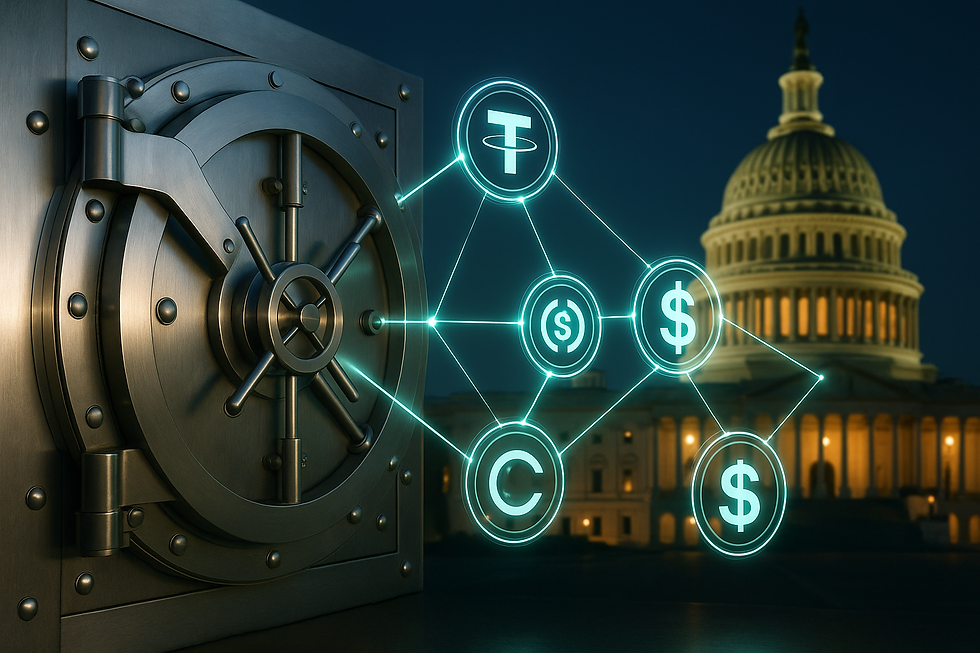Senate Passes GENIUS Act to Regulate Stablecoins
- BlocBerg
- Jun 18
- 3 min read

Introduction
In a major move for the crypto ecosystem, the U.S. Senate passed the GENIUS Act (Guidelines for Ensuring National Innovation and Uniform Stability) on June 17, 2025, with a 68–30 bipartisan vote. The bill marks a pivotal moment, establishing the first comprehensive federal framework for stablecoins. For crypto investors, fintech startups, and large institutions such as Visa and Amazon, this legislation signals long-awaited regulatory clarity that could pave the way for mainstream adoption.
Whether you're holding USDC, building on Ethereum, or exploring tokenized payments for your business, the GENIUS Act changes the game.
What Is the GENIUS Act and Why It Matters
1:1 Reserve Requirements & Federal Oversight
At its core, the GENIUS Act mandates that all U.S.-issued stablecoins must be backed by dollar-denominated reserves held in FDIC-insured banks or equivalent custodians. It places the authority for licensing and supervision under the Federal Reserve and OCC (Office of the Comptroller of the Currency).
Key Details
All stablecoin issuers must undergo periodic audits
Only licensed entities can issue U.S. dollar-backed stablecoins
Reserve assets must be transparent and independently verified
Key Details
All stablecoin issuers must undergo periodic audits
Only licensed entities can issue U.S. dollar-backed stablecoins
Reserve assets must be transparent and independently verified
Institutional Confidence Grows: Circle, Tether, and BigTech React
A Green Light for Corporate Adoption
Industry giants like Circle (USDC issuer) and Tether (USDT) have welcomed the legislation, emphasizing that legal clarity enhances consumer trust and opens the door to further collaboration with banks and payment networks. Companies like Visa, Amazon, and Stripe have expressed renewed interest in stablecoin integrations post-vote.
Implications
Accelerated corporate integration of stablecoin payments
Enhanced interoperability with fiat rails
Boosted confidence in DeFi and Web3 finance
Quote:"This bill gives us the legal certainty to expand USDC globally, responsibly, and securely."— Jeremy Allaire, CEO of Circle
Global Ripple Effects & Stablecoin Geography
How the U.S. Framework May Influence the EU, Asia, and Emerging Markets
As the U.S. asserts regulatory leadership with the GENIUS Act, other jurisdictions—such as the EU's MiCA regulation—will likely reevaluate their frameworks to stay competitive in fintech innovation. Countries like Singapore, Japan, and Brazil already have pilot programs for CBDCs and stablecoin integration.
Government & Regulatory Bodies to Watch
European Central Bank (ECB)
Monetary Authority of Singapore (MAS)
Financial Conduct Authority (UK)
Impact on Audience:
Crypto businesses gain clearer expansion routes into U.S. markets
Developers and DeFi platforms must ensure token compliance
Regulators worldwide face mounting pressure to coordinate policy
What to Watch / How to Prepare Practical Steps for Founders, Investors, and Builders
Compliance Checklist for Stablecoin Projects
Conduct third-party reserve audits
Partner with FDIC-insured custodians
Consult U.S. legal experts on money transmitter licensing
Upcoming Dates to Watch
July 15: House of Representatives vote
August 2025: Expected stablecoin issuer guidance from OCC
Q4 2025: Compliance enforcement begins
Market Volatility Note: Bitcoin Eyes Big Move After $103K Retest
While the GENIUS Act created tailwinds for regulation, Bitcoin (BTC) faced downward pressure, dropping ~4.5% to the $103K level due to escalating Middle East tensions. Technical analysts on TradingView suggest BTC could be primed for a breakout—either up or down—within the next 72 hours.
Traders Take Note:
Tighten stop losses
Watch BTC dominance and altcoin rotation
Look for news catalysts from macro and geopolitical angles
Conclusion: Toward a Regulated and Resilient Stablecoin Future
The GENIUS Act is a watershed moment for the digital finance sector. By bringing stablecoin issuance into a regulated, transparent framework, it legitimizes a cornerstone of crypto’s payment infrastructure. Whether you're a developer building cross-chain solutions, an investor navigating digital assets, or a regulator designing policies, the road ahead is clearer—and more interconnected—than ever.
📩 Stay ahead of crypto legislation and innovation. Subscribe to BlocBerg.com for expert news, trends, and breakdowns.



Comments